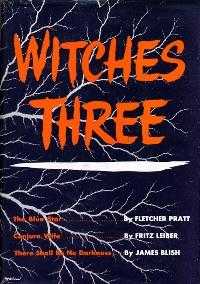Witches Three
| Witches Three | |
|---|---|
 Dust-jacket from the first edition | |
| Author | edited by Fletcher Pratt |
| Country | United States |
| Language | English |
| Series | Twayne Triplets |
| Genre | Science fiction |
| Publisher | Twayne |
Publication date | 1952 |
| Media type | Print (Hardback) |
| Pages | 423 pp |
| OCLC | 11454764 |
| Preceded by | The Petrified Planet |
Witches Three is an anthology of three original fantasy stories, edited by the uncredited Fletcher Pratt and published in hardcover by Twayne in 1952.[1] No further editions of the anthology were issued, but each of the stories was later republished.
Witches Three was the second and last in the publisher's "Twayne Triplets,"[2] a series of science fiction and fantasy anthologies of which each was to be written by a trio of writers on a common theme. The theme for Witches Three is witches and witchcraft.
Contents
"Introduction" (John Ciardi) The opening piece discusses "the symbolism of witches, in these stories and in folklore generally."[3]
"Conjure Wife" (Fritz Leiber) Tansy Saylor is the wife of an up-and-coming young sociology professor at a small, conservative American college. She is also a witch. Her husband, Norman, discovers this one day while rummaging through her dressing table: he finds vials of graveyard dirt, packets of hair and fingernail clippings from their acquaintances, and other evidence of her witchcraft. He confronts Tansy, and manages to convince her that her faith in magic is a result of superstition and neurosis. Tansy burns her charms; and Norman's luck immediately goes sour. He realizes that he had been protected, up til now, by Tansy's charms, and that as a result of his meddling, they are both now powerless to counteract the spells and charms of the other witches all around them.
"There Shall Be No Darkness" (James Blish) A wealthy man named Tom Newcliffe has invited a group of artists and friends together for a weekend gathering in the Scottish countryside. One of these, painter Paul Foote, detects hints that another, Polish concert pianist Jan Jarmoskowski, may in fact be a werewolf. He is proven right; the musician transforms under the light of the full moon. The guests prepare makeshift silver bullets and attempt to track him, but the only result is a dead hunting dog and wasted ammunition. The group fortifies itself inside the mansion to wait for their quarry to return, at which point they hope to be able to defeat him. The revelation of Doris, another member of the group, as a witch is important to the story's resolution.
"The Blue Star" (Fletcher Pratt) In a parallel world, witchcraft is a hereditary talent running in families, passed down from mother to daughter with daughter's loss of virginity. The daughter's lover then acquires the new witch's magical talisman, a jewel known as the blue star, which enables him to read the mind of anyone he looks in the eye. Rodvard Bergelin, a member of the radical Sons of the New Day, seduces the hereditary witch Lalette Asterhax to use her blue star against a repressive imperial government that has banned witchcraft. Both are pawns in the revolutionary movement, which soon goes bad, forcing the couple to flee the empire. Various adventures and complications ensue as they stray into one cause or acquaintance after another, gradually growing beyond their shallow, selfish roots into a greater understanding.
Reception
Basil Davenport, reviewing the anthology in The New York Times, called the book "an unusually generous omnibus," the contents of which he regarded as "all of high quality." He comments on each of the contributions individually. He praised John Ciardi's "highly perceptive introduction" and finds "real excitement" in Leiber's "comedy-melodrama," highlighting its central idea as "one of those ... of which you say, 'Why, I never thought of that before, but it's obviously perfectly true!" Blish's story he calls "an ironic tragedy of a werewolf in spite of himself." His highest praise, however, is reserved for Pratt's, "[t]he most ambitious and most stimulating of the stories . . . a romance with a scope far beyond that of the common science-fiction novel." In summation, he calls the volume "one more proof that science-fiction is really growing up."[3]
"If you are weary of gleaming spaceships and bug-eyed monsters on distant planets," wrote The Washington Post, "try these comparatively old-fashioned tales of horror and witchcraft. The reviewer called the authors "old hands at conjuring up suspense and fear," and stated that "[a]n idle hour or two in this company can be quite diverting."[4]
The anthology was also reviewed by the editors of The Magazine of Fantasy & Science Fiction in the issue for January 1953, Groff Conklin in Galaxy Science Fiction, March 1953, Sam Moskowitz in Science-Fiction Plus, June 1953, Damon Knight in Science Fiction Adventures, May 1953, and Mark Reinsberg in Imagination, August 1953.[1]
References
- ↑ 1.0 1.1 Witches Three title listing at the Internet Speculative Fiction Database
- ↑ Twayne Triplets title listing at the Internet Speculative Fiction Database
- ↑ 3.0 3.1 Davenport, Basil. "Out of This World," in The New York Times, Dec. 14, 1952, p. BR16.
- ↑ "Nutshell Reviews," in The Washington Post, Jan. 4, 1953, p. B6.